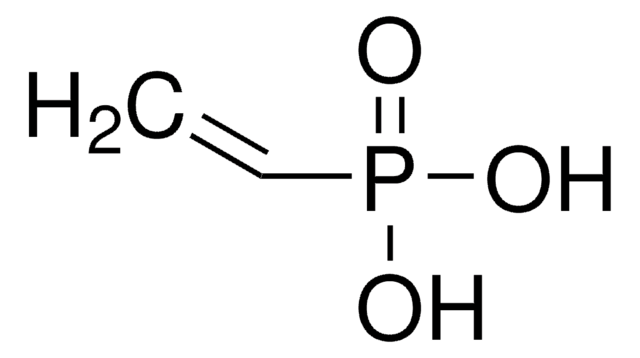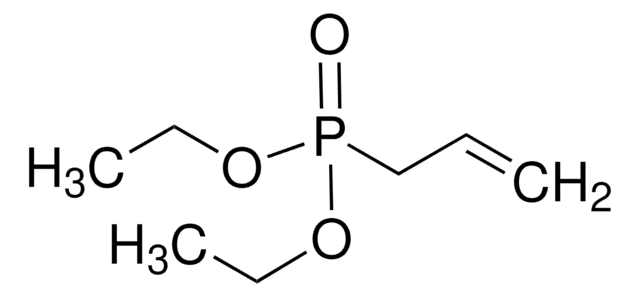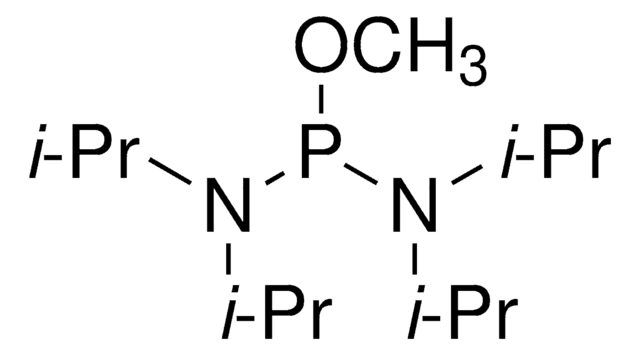Products may be shipped at a different temperature than the recommended long-term storage temperature. If the product quality is sensitive to short-term exposure to conditions other than the recommended long-term storage, it will be shipped on wet or dry-ice. If the product quality is NOT affected by short-term exposure to conditions other than the recommended long-term storage, it will be shipped at ambient temperature. As shipping routes are configured for minimum transit times, shipping at ambient temperature helps control shipping costs for our customers. For more information, please refer to the Storage and Transport Conditions document: https://www.sigmaaldrich.com/deepweb/assets/sigmaaldrich/marketing/global/documents/316/622/storage-transport-conditions-mk.pdf
496758
Bis[2-(methacryloyloxy)ethyl] phosphate
Synonym(s):
2-Hydroxyethyl methacrylate phosphate, Bis(2-methacryloyloxyethyl) acid phosphate, Bis(2-methacryloyloxyethyl) hydrogen phosphate, Bis(methacryloyloxyethyl) hydrogen phosphate, Bis(methacryloyloxyethyl) phosphate, Bis[2-(methacryloyloxy)ethyl] phosphate, Di(2-methacryloyloxyethyl) phosphate, Di-2-methacryloyloxyethyl acid phosphate
About This Item
Recommended Products
refractive index
n20/D 1.47 (lit.)
bp
221 °C (lit.)
density
1.28 g/mL at 25 °C (lit.)
storage temp.
2-8°C
SMILES string
CC(=C)C(=O)OCCOP(O)(=O)OCCOC(=O)C(C)=C
InChI
1S/C12H19O8P/c1-9(2)11(13)17-5-7-19-21(15,16)20-8-6-18-12(14)10(3)4/h1,3,5-8H2,2,4H3,(H,15,16)
InChI key
NXBXJOWBDCQIHF-UHFFFAOYSA-N
Related Categories
General description
Application
- As a bifunctional crosslinker to synthesize superabsorbent polymers (SAPs) via free radical polymerization. These SAPs can be used for agricultural applications.
- To prepare self-etching primer formulations for enamel and dentine. Primers with BMEP exhibit good wetting, etching, and penetration in both dentine and enamel.
- As a precursor to synthesize fire retardant nanocomposites via suspension polymerization.
Features and Benefits
- Presence of dimethacrylate groups enables cross-linking and improves copolymerization.
- Hydrophilicity and short carbon chains can enhance wetting.
Signal Word
Warning
Hazard Statements
Precautionary Statements
Hazard Classifications
Eye Irrit. 2 - Skin Irrit. 2 - STOT SE 3
Target Organs
Respiratory system
Storage Class Code
10 - Combustible liquids
WGK
WGK 3
Flash Point(F)
Not applicable
Flash Point(C)
Not applicable
Personal Protective Equipment
Choose from one of the most recent versions:
Already Own This Product?
Find documentation for the products that you have recently purchased in the Document Library.
Customers Also Viewed
-
How is shipping temperature determined? And how is it related to the product storage temperature?
1 answer-
Helpful?
-
-
How can I determine the shelf life / expiration / retest date of this product?
1 answer-
If this product has an expiration or retest date, it will be shown on the Certificate of Analysis (COA, CofA). If there is no retest or expiration date listed on the product's COA, we do not have suitable stability data to determine a shelf life. For these products, the only date on the COA will be the release date; a retest, expiration, or use-by-date will not be displayed.
For all products, we recommend handling per defined conditions as printed in our product literature and website product descriptions. We recommend that products should be routinely inspected by customers to ensure they perform as expected.
For products without retest or expiration dates, our standard warranty of 1 year from the date of shipment is applicable.
For more information, please refer to the Product Dating Information document: https://www.sigmaaldrich.com/deepweb/assets/sigmaaldrich/marketing/global/documents/449/386/product-dating-information-mk.pdfHelpful?
-
Active Filters
Our team of scientists has experience in all areas of research including Life Science, Material Science, Chemical Synthesis, Chromatography, Analytical and many others.
Contact Technical Service

![[2-(Methacryloyloxy)ethyl]dimethyl-(3-sulfopropyl)ammonium hydroxide 95%](/deepweb/assets/sigmaaldrich/product/structures/217/219/73c91e1c-0ee4-4b3d-bead-a6dc3d09d1da/640/73c91e1c-0ee4-4b3d-bead-a6dc3d09d1da.png)











